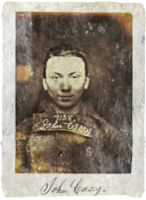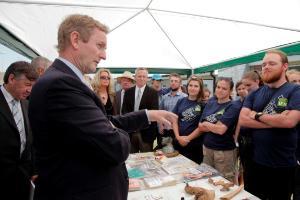The Spike Island Project
.png)
The Spike Island Archaeological Project
Project Director: Dr Barra Ó Donnabháin
Spike Island, Ireland's Alcatraz, is located at the mouth of the large natural harbour at Cork. Originally a Napoleonic era fortress, it was converted to a convict prison in 1847, the worst year of the Great Famine (1845-1852). The prison was part of the British colonial government's response to the rise in public disorder that characterised the famine and in its early years, Spike Island was an important holding centre for convicts transported to Australia and Bermuda. Political prisoners such as the Young Irelander, John Mitchel (after whom the fort is now named) and Fenians were also incarcerated on Spike. Records indicate that over 1000 convicts were buried on the island by the time the prison closed in 1883, with most dying in the first decade of its operation.
 |
|---|
The Spike Island Archaeological Project investigates the nature of 19th century convict prison. In Ireland and Britain, long-term confinement only became the dominant means of punishment and social control in the early decades of the 19th century. That century was critical in the development of the modern prison system. The architecture of many of the purpose-built prisons from this period reflects new ideas about the redemptive nature of isolation, discipline and work. Prisons were dramatic physical expressions of state power but they were also locations in which such authority could be contested. Behind the forbidding facade of the institution lay the individual experience of the prisoner and prison warder. Our project investigates this triangle of relationships between convicts, their keepers and the institution.
The project will study the material culture of the prison, the buildings used to house convicts and warders, and the cemetery area where prisoners were buried in unmarked plots. A survey of graffiti in the remaining upstanding buildings will be carried out as a means of accessing convicts' attitudes to their incarceration. Sub-floor deposits in a prison block, the punishment cells and the warders accommodations have to potential to yield material culture correlated with these differing contexts. The site of one of the few purpose-built prison buildings, the since demolished 'Iron Prison' will also be excavated in future seasons.
 |
 |
|---|
The prison had a high mortality rate in the early years and this was matched by complaints about how unsuited the prisoners were for employment due to their general debility. Yet the landscape of the island today, along with the form of extensive naval docks on nearby Haulbowline Island and many other military installations around Cork harbour, reflect the input of forced convict labour.
By telling the stories of the men and boys who were incarcerated, laboured and died in the prison on Spike Island, the integrated study of skeletal remains and material culture will give a voice to those silenced in the past and tell of the lived experience of penal servitude. This project has relevance beyond Ireland and the Irish diaspora: the 19th century was a critical period for the development of the modern prison system with considerable innovation and experimentation in methods of incarceration. Spike Island was one of the locations where such experimentation was carried out. It was one of the hubs of a penal system that had a global reach. The Project aims to give voice to the live experience of incarceration while also broadening our understanding of the role of the convict prison as one of the mechanisms by which empire was established and maintained.
Initial work on the project began in 2012, with a four-week excavation and field recording programme due to get underway in July 2013. The project is being directed by Dr. Barra Ó Donnabháin and is being run in conjunction with the Institute for Field Research (IFR).
Project updates will be posted on this page into the future.
- Visit the IFR website (external link)
- Visit the IFR Spike Project page (external link)
- Visit www.spikeislandcork.ie (external link)
Video: 2014 Season
No Flash Player? - Direct link to Gallery (Google+)
Project News
28 October 2013
The Spike Island Documentary Series in the Irish Examiner, 28 October 2013
Documentary series to provide insight into history of Spike Island by Eoin English
http://www.irishexaminer.com/ireland/documentary-series-to-provide-insight-into-history-of-spike-island-247616.html (external link)
06 August 2013
The Spike Island Archaeological Project in the Evening Echo, 06 August 2013
Grim Spike find holds the key to who we are by Maria Rolston
Read the article here (PDF): Evening Echo_060813_Spike (1,703kB)
02 August 2013
The Spike Island Archaeological Project in the Evening Echo, 02 August 2013
Spike: Digging up the dirt by Maria Rolston
Read the article here (PDF): Evening Echo_020813_Spike (2,959kB)
01 August 2013
The Spike Island Archaeological Project in the Irish Examiner, 1st August 2013
Dig reveals full extent of convicts' mass grave on Spike Island by Eoin English
http://www.irishexaminer.com/ireland/dig-reveals-full-extent-of-convicts-mass-grave-on-spike-island-238496.html (external link)
31 July 2013
The Spike Island Archaeological Project in the Evening Echo, 31 July 2013
Rebel Passports for Spike Adventurers by Maria Rolston
Read the article here (PDF): Evening Echo_310713_Spike (1,292kB)
11 July 2013
An Taoiseach, Mr. Enda Kenny, steps into the past on Spike Island where he met with the Spike Island Archaeological Project Team on his recent visit to mark the 75th anniversary of the handover of the Cork Harbour Treaty Forts.
Following a sod-turning ceremony to mark the launch of development on the new Beaufort Research Laboratory at Ringaskiddy, An Taoiseach, Mr. Enda Kenny, and other guests, including the Minister for Agriculture, Food and the Marine, Mr. Simon Coveney, and UCC President, Dr. Michael Murphy, made the short boat trip to Spike Island for the commemoration ceremony. The events included a ceremonial flag-raising and gun salute, and guests had the opportunity to meet with the Spike Archaeological Project Team and view some of their findings to date. Events on the day also included a full island tour and a public discussion on the historical backdrop to the handover of the Treaty Ports, which was hosted by Myles Dungan and included speakers Dr. Dermot Keogh, Dr. Mervyn O'Driscoll and Mr. Joe Lankford.
 |
|---|
Video: Spike Island - A UCC Documentary
2014 Season:
Spike Island: A UCC Documentary
Trailer
Part 1: The Island Prison
Part 2: Convict Life
Part 3: The Student Experience
Part 4: The Punishment Block
Part 5: Convict Burial Ground
